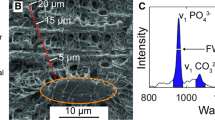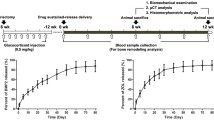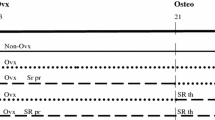Abstract
Sixteen-week-old Sprague-Dawley rats were ovariectomized (Ovx) or sham-operated and housed for 8 weeks to develop osteopenia prior to systemic administration of rhIGF-I (0.9 and 2.6 mg/kg) alone or the rhIGF-I/IGFBP-3 (0.9, 2.6 and 7.5 mg/kg) complex. After 8 weeks of treatment, proximal femurs were fixed, embedded, and cut through the midneck region. Structural and dynamic histomorphometric analyses were performed using standard techniques. Ovx increased endocortical resorption and modeling-dependent periosteal formation which resulted in decreased cortical bone area. Despite increased bone formation, trabecular number, thickness, and area were all reduced due to increased resorption. Structural changes following Ovx included fewer struts and nodes, a higher percentage of the simpler strut forms, and reduced endocorticotrabecular cnnnectivity. Eight weeks of treatment with rhIGF-I or rhIGF-I/IGFBP-3 promoted periosteal and endocortical bone formation and reduced the endocortical resorption induced by Ovx. Both rhIGF-I formulations stimulated bone formation on existing trabecular surfaces which increased trabecular thickness and area but not trabecular number. These treatments prevented further deterioration of the trabecular network caused by Ovx and preserved endocortico-trabecular connectivity. In summary, changes in the femoral neck following Ovx appear to be similar in rats and humans. The highest dose of rhIGF-I/IGFBP-3 used in this study showed the best results in promoting cortical and cancellous bone formation, and appears to be promising therapy for human osteopenias.
Similar content being viewed by others
References
Melton LJ (1993) Hip fractures: a worldwide problem today and tomorrow. Bone 14:S1-S8
Wasnich R (1993) Bone mass measurement: prediction of risk. Am J Med 95(suppl. 5A):6S-10S
Boyce TM, Bloebaum RD (1993) Cortical aging differences and fracture implications for the human femoral neck. Bone 14:769–778
Parfitt AM (1984) Age-related structural changes in trabecular and cortical bone: cellular mechanisms and biomechanical consequences. Calcif Tissue Int 36:S123-S128
Werner C, Iversen BF, Therkildsen MH (1988) Contribution of the trabecular component to mechanical strength and bone mineral content of the femoral neck. Scand J Clin Lab Invest 48: 457–460
Martens M, Van Audekercke R, Delport P, De Meester P, Mulier JC (1983) The mechanical characteristics of cancellous bone at the upper femoral region. J Biomech 12:971–983
Mazes RB (1990) Fracture risk: a role for compact bone. Calcif Tissue Int 47:191–193
Kalu DN (1991) The ovariectomized rat model of postmenopausal bone loss. Bone Miner 15:175–192
Frost HM, Jee WSS (1992) On the rat model of human osteopenias and osteoporoses. Bone Miner 18:227–236
Wüster C, Blum WF, Schlemilch S, Ranke MB, Ziegler R (1993) Decreased serum levels of insulin-like growth factors and IGF binding protein 3 in osteoporosis. J Internal Med 234:249–255
Bagi CM, Brommage R, DeLeon L, Adams S, Rosen D, Sommer A (1994) Benefit of systemically administered rhIGF-I and rhIGF-I/IGFBP-3 on cancellous bone in ovariectomized rats. J Bone Miner Res 9:1301–1312
Miller SC, Shupe JG, Redd EH, Miller MA, Omura TH (1986) Changes in bone mineral and bone formation rates during pregnancy and lactation in rats. Bone 7:283–287
Parfitt AM, Drezner MK, Glorieux FH, Kanis JA, Malluche H, Meunier PJ, Ott SM, Recker RR (1987) Bone histomorphometry: standardization of the nomenclature, symbols and units. Report of the ASBMR Histomorphometry Committee. J Bone Miner Res 2:595–610
Miller SC, Wronski TJ (1993) Long-term osteopenic changes in cancellous bone structure in ovariectomized rats. Anat Rec 236: 433–441
Bagi CM, Miller SC (1994) Comparison of osteopenic changes in cancellous bone induced by ovariectomy and/or immobilization in adult rats. Anat Rec 239:243–254
Miller SC, Bowman BM, Miller MA, Bagi CM (1991) Calcium absorption and osseous organ- tissue- and envelope-specific changes following ovariectomy in rats. Bone 12:439–446
Bagi CM, Mecham M, Weiss J, Miller SC (1993) Comparative morphometric changes in rat cortical bone following ovariectomy and/or immobilization. Bone 14:877–883
Garn SM, Frisancho AR, Sandusky ST, McCann MB (1972) Confirmation of the sex differences in continuing subperiosteal apposition. Am J Phys Anthropol 36:377–380
Ruff CB, Hayes WC (1988) Sex differences in age-related remodeling of the femur and tibia. J Orthop 6:886–896
Bagi CM, DeLeon E, Brommage R, Adams S, Rosen D, Sommer A Systemic administration of rhIGF-I or rhIGF-I/IGFBP-3 increase cortical bone and lean body mass in ovariectomized rats. Bone (suppl.) 16:(in press)
Singh M, Nagrath AR, Maini PS, Hariana R (1970) Changes in trabecular pattern of the upper end of the femur as an index of osteoporosis. J Bone Joint Surg 52:457–467
Martin RB, Atkinson PJ (1977) Age and sex-related changes in the structure and strength of the human femoral shaft. J Biomech 10:223–231
Sernbo I, Johnell O (1987) Changes in bone mass and fracture type in patients with hip fractures. Clin Orthop Rel Res 238: 139–147
Cordey J, Schneider M, Belendez C, Ziegler WJ, Rahn BA, Perren SM (1992) Effect of bone size, not density, on the stiffness of the proximal part of normal and osteoporotic human femora. J Bone Miner Res 2:S437-S444
Søgaard CH, Wronski TJ, McOsker JE, Mosekilde L (1994) The positive effect of parathyroid hormone on femoral neck bone strength in ovariectomized rats is more pronounced than that of estrogen or bisphosphonates. Endocrinology 134:650–657
Peng Z, Tuukkanen J, Väänänen HK (1994) Exercise can provide protection against bone loss and prevent the decrease in mechanical strength of femoral neck in ovariectomized rats. J Bone Miner Res 9:1559–1564
Author information
Authors and Affiliations
Rights and permissions
About this article
Cite this article
Bagi, C.M., DeLeon, E., Brommage, R. et al. Treatment of ovariectomized rats with the complex of rhIGF-I/IGFBP-3 Increases cortical and cancellous bone mass and improves structure in the femoral neck. Calcif Tissue Int 57, 40–46 (1995). https://doi.org/10.1007/BF00298995
Received:
Accepted:
Issue Date:
DOI: https://doi.org/10.1007/BF00298995




